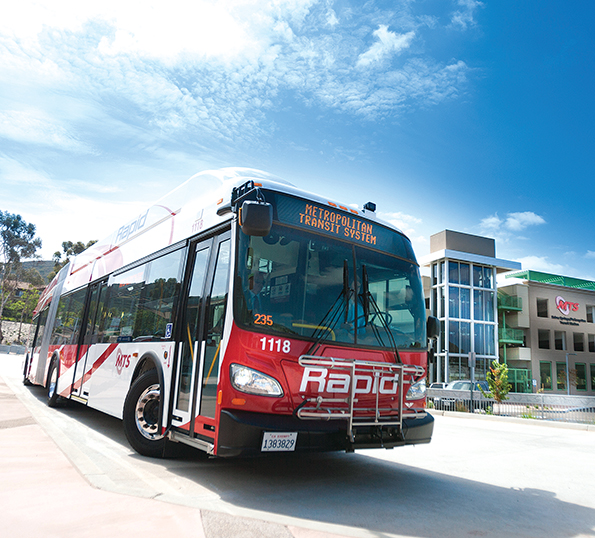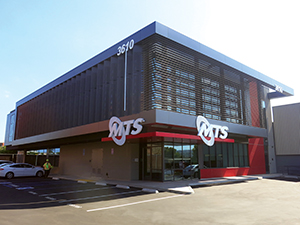

CEO
San Diego Metropolitan
Transit System
Necessity has definitely made all of us inventive in the transit industry. After emerging from a long period of adversity – a major recession, state funding cutbacks, service cuts, fare increases and staff layoffs — many transit systems are now stronger than ever. That is certainly the case with the San Diego Metropolitan Transit System.
—————————————————————————————————————————————
YOU MIGHT ALSO LIKE:
- VIA Transit Police locate missing children
- Metro bus driver rescued Ohio residents from fire
- VIA receives $35 million from TxDOT for bus transit improvements
—————————————————————————————————————————————
Over the last 10 years, while the industry has struggled against all those outside factors, MTS has made significant advancements in both its bus and light rail systems:
• MTS ridership hit an all-time record high last year with 95 million trips on its 90-plus fixed-route bus services and its 53 miles of light rail. We are now averaging more than 300,000 trips per weekday.
• Our fleets of more than 700 buses and 120 rail cars have never been in better shape. More than 80 percent of our buses run on clean compressed natural gas. Our entire Trolley network will have low-floor cars by the end of the year. We have ongoing bus procurement contracts to replace buses as they reach retirement age.
• Maintenance is tip-top. For our bus operations, mileage between breakdowns is now more than 12,000 miles, up from just 4,000 miles seven years ago.
• We just expanded and opened a new $30 million, LEED-certified bus maintenance facility in the South Bay area of San Diego. We are breaking ground on a similar facility in East County this year. Three years ago we purchased a facility from a recreational vehicle dealership to house our paratransit fleet and maintenance operation.
• We launched our first Bus Rapid Transit service last summer and ridership is already exceeding expectations. Two more BRT lines open in October.
• We are nearing completion on a $660 million renovation of two of our trolley lines.
• We revamped pension plans for both represented and non-represented employees.
• We are using technology to track ridership and provide convenience for our customers through smart cards and a mobile ticketing pilot program called mTicket.
• Our key performance indicators, such as farebox recovery and costs per passenger, are all at the top or near the top when compared to our peer agencies.
None of this happens without focusing on the details; without a dedicated team of professionals. Our success depends on critical thinking and planning well into the future — and there is nothing like necessity for motivation.
When I arrived at MTS a little more than 10 years ago, our bus network had not received a lot of attention as the agency focus was on light rail development. Routes were inefficient. Work rules for bus operators made it difficult to manage employees. Maintenance protocols were lacking. A complete overhaul was necessary.
We immediately conducted a Comprehensive Operational Analysis of the entire bus system. We analyzed every segment of every route and evaluated each one according to a market-based philosophy. The directive was to develop a plan that allocated our resources where we would attract the most riders at the lowest costs.
At the end of this exercise, which included extensive customer outreach, special night board meetings, and customized web pages, we altered every route in some way; and our success was immediate. We cut $9 million on the expense side and increased ridership by 9 percent. Today, our revenue miles have climbed back up to where they were before the changes, but ridership is up
31 percent.
Fortunately, we made these changes before the recession hit and when it did we were “right-sized” to weather the storm a little easier.

Of course, success also depends on making tough decisions. When funding and tax revenues dropped precipitously, MTS quickly proposed and ultimately implemented fare changes that increased monthly passes from $60 to $72. We also eliminated transfers from bus-to-bus for one-way fares.
Tough negotiations also took place with our bus operators and their unions. But to their credit, they accepted work rule changes to make it much more manageable to schedule work and to rely on attendance. Over the last decade we have renegotiated 14 labor contracts without a work stoppage. MTS also made tough employment decisions at the management level, reducing management staff by more than 20 percent during the recession.
All of this contributed to our high farebox recovery ratio. For bus, it is around 38 percent and over 50 percent for rail. Our subsidy per passenger of $1.65 is the lowest among our peers.
Necessity plays a role in that as well. MTS receives about one-eighth of a cent in a local sales tax dedicated to freeway, road and transit. That is much less than in other communities. We have to be efficient.
MTS has squarely positioned itself to set even higher ridership records. I’d like to think we will surpass 100 million rides this fiscal year.
A lot is working in our favor to reach this milestone. The first of our BRT services, called Rapid, will be fully operational the entire fiscal year. This route, which runs north-south on the inland transportation corridor, along with a series of adjustments to other supporting services, has increased ridership on the corridor by 34 percent. For the current fiscal year, we project 500,000 more rides in that corridor alone. Two more routes have the potential to increase ridership in their respective corridors as well.
Passengers are not only enjoying more frequent and much faster service over a greater span, new amenities such as dedicated stations, parking structures, next arrival signage, signal priority and new buses with high-back cushioned seats are improving their transit experience.
We are also about to ink a new contract for about half of our fixed-route bus services. This deal could be for as long as 12 years with a value approaching $1 billion and will continue to keep our service levels high and our operational costs low.
Today, our bus system is growing and our team is rising to the challenge as we train more than 400 operators on the service and make all of the necessary infrastructure changes to support it. We are thoroughly modernizing our Trolley system as plans progress for an 11-mile north-south extension along our coastal transportation corridor. There is growing recognition that public transit must be a part of the region’s growth strategies.
It is an exciting time for MTS. Public transit has come of age in San Diego.
